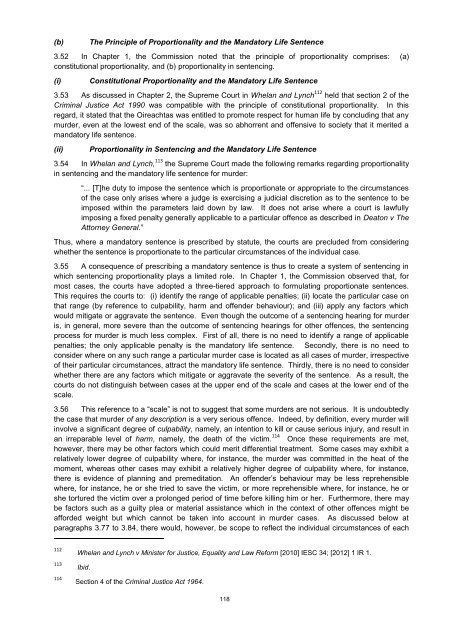Report on Mandatory Sentences - Law Reform Commission
Report on Mandatory Sentences - Law Reform Commission
Report on Mandatory Sentences - Law Reform Commission
Create successful ePaper yourself
Turn your PDF publications into a flip-book with our unique Google optimized e-Paper software.
(b)<br />
The Principle of Proporti<strong>on</strong>ality and the <strong>Mandatory</strong> Life Sentence<br />
3.52 In Chapter 1, the Commissi<strong>on</strong> noted that the principle of proporti<strong>on</strong>ality comprises: (a)<br />
c<strong>on</strong>stituti<strong>on</strong>al proporti<strong>on</strong>ality, and (b) proporti<strong>on</strong>ality in sentencing.<br />
(i)<br />
C<strong>on</strong>stituti<strong>on</strong>al Proporti<strong>on</strong>ality and the <strong>Mandatory</strong> Life Sentence<br />
3.53 As discussed in Chapter 2, the Supreme Court in Whelan and Lynch 112 held that secti<strong>on</strong> 2 of the<br />
Criminal Justice Act 1990 was compatible with the principle of c<strong>on</strong>stituti<strong>on</strong>al proporti<strong>on</strong>ality. In this<br />
regard, it stated that the Oireachtas was entitled to promote respect for human life by c<strong>on</strong>cluding that any<br />
murder, even at the lowest end of the scale, was so abhorrent and offensive to society that it merited a<br />
mandatory life sentence.<br />
(ii)<br />
Proporti<strong>on</strong>ality in Sentencing and the <strong>Mandatory</strong> Life Sentence<br />
3.54 In Whelan and Lynch, 113 the Supreme Court made the following remarks regarding proporti<strong>on</strong>ality<br />
in sentencing and the mandatory life sentence for murder:<br />
“... [T]he duty to impose the sentence which is proporti<strong>on</strong>ate or appropriate to the circumstances<br />
of the case <strong>on</strong>ly arises where a judge is exercising a judicial discreti<strong>on</strong> as to the sentence to be<br />
imposed within the parameters laid down by law. It does not arise where a court is lawfully<br />
imposing a fixed penalty generally applicable to a particular offence as described in Deat<strong>on</strong> v The<br />
Attorney General.”<br />
Thus, where a mandatory sentence is prescribed by statute, the courts are precluded from c<strong>on</strong>sidering<br />
whether the sentence is proporti<strong>on</strong>ate to the particular circumstances of the individual case.<br />
3.55 A c<strong>on</strong>sequence of prescribing a mandatory sentence is thus to create a system of sentencing in<br />
which sentencing proporti<strong>on</strong>ality plays a limited role. In Chapter 1, the Commissi<strong>on</strong> observed that, for<br />
most cases, the courts have adopted a three-tiered approach to formulating proporti<strong>on</strong>ate sentences.<br />
This requires the courts to: (i) identify the range of applicable penalties; (ii) locate the particular case <strong>on</strong><br />
that range (by reference to culpability, harm and offender behaviour); and (iii) apply any factors which<br />
would mitigate or aggravate the sentence. Even though the outcome of a sentencing hearing for murder<br />
is, in general, more severe than the outcome of sentencing hearings for other offences, the sentencing<br />
process for murder is much less complex. First of all, there is no need to identify a range of applicable<br />
penalties; the <strong>on</strong>ly applicable penalty is the mandatory life sentence. Sec<strong>on</strong>dly, there is no need to<br />
c<strong>on</strong>sider where <strong>on</strong> any such range a particular murder case is located as all cases of murder, irrespective<br />
of their particular circumstances, attract the mandatory life sentence. Thirdly, there is no need to c<strong>on</strong>sider<br />
whether there are any factors which mitigate or aggravate the severity of the sentence. As a result, the<br />
courts do not distinguish between cases at the upper end of the scale and cases at the lower end of the<br />
scale.<br />
3.56 This reference to a “scale” is not to suggest that some murders are not serious. It is undoubtedly<br />
the case that murder of any descripti<strong>on</strong> is a very serious offence. Indeed, by definiti<strong>on</strong>, every murder will<br />
involve a significant degree of culpability, namely, an intenti<strong>on</strong> to kill or cause serious injury, and result in<br />
an irreparable level of harm, namely, the death of the victim. 114 Once these requirements are met,<br />
however, there may be other factors which could merit differential treatment. Some cases may exhibit a<br />
relatively lower degree of culpability where, for instance, the murder was committed in the heat of the<br />
moment, whereas other cases may exhibit a relatively higher degree of culpability where, for instance,<br />
there is evidence of planning and premeditati<strong>on</strong>. An offender’s behaviour may be less reprehensible<br />
where, for instance, he or she tried to save the victim, or more reprehensible where, for instance, he or<br />
she tortured the victim over a prol<strong>on</strong>ged period of time before killing him or her. Furthermore, there may<br />
be factors such as a guilty plea or material assistance which in the c<strong>on</strong>text of other offences might be<br />
afforded weight but which cannot be taken into account in murder cases. As discussed below at<br />
paragraphs 3.77 to 3.84, there would, however, be scope to reflect the individual circumstances of each<br />
112<br />
113<br />
114<br />
Whelan and Lynch v Minister for Justice, Equality and <strong>Law</strong> <strong>Reform</strong> [2010] IESC 34; [2012] 1 IR 1.<br />
Ibid.<br />
Secti<strong>on</strong> 4 of the Criminal Justice Act 1964.<br />
118
















